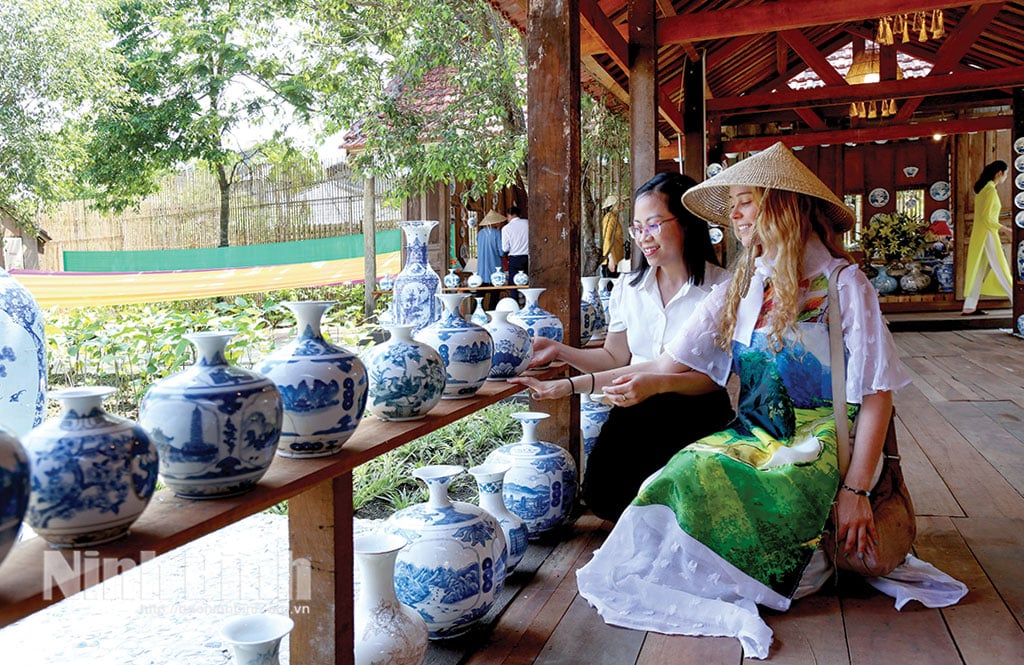
From living heritage to creative materials
As an inseparable part of the ancient Hoa Lu Capital, traditional craft villages have a special position in shaping the unique cultural values of Ninh Binh . Not only is it a place to preserve traditional handicraft techniques, craft villages are also a living testament to the combination of folk art and royal culture. The presence of craft villages right in the heart of the heritage area has created a special cultural - tourism - community ecosystem, helping visitors deeply feel the spirit of the ancient capital, while creating favorable conditions for the development of unique cultural industries.
Prominent among them are the craft villages of Van Lam embroidery, Bo Bat pottery, Ninh Van fine art stone, Tong Xa bronze casting, Kim Son sedge weaving, La Xuyen carpentry, etc. This is not only a place for handicraft production but also a vibrant space of heritage, where tangible and intangible values coexist, contributing to shaping local identity. These craft villages all have a history of hundreds of years, associated with the names of craft founders such as Ly Quoc Su Nguyen Minh Khong - founder of bronze casting, Ninh Huu Hung - founder of carpentry. In traditional festivals such as Truong Yen, Trang An, Doi Son, craft village products are solemnly present in rituals. Many villages have temples to worship craft founders, strengthening the connection between culture, beliefs and community. Crafts and craft villages become part of the sacred cultural structure, connecting memories and the present.
In that spirit, businesses in the craft village have innovated and produced traditional handicraft products with high applications in daily life and as tourist gifts that are favored by domestic and international customers. Ms. Barbel Maessen, a tourist from Germany, shared: “I am impressed by the way people here attach handicrafts to community life. I not only get to see but also directly make embroidery products, which is a valuable experience when coming to Ninh Binh”.
In the hands of artisans, each product contains aesthetic value and cultural spirit. The connection between craft villages and experiential tourism is opening up a new direction. Artisan Pham Van Vang, Director of Bo Bat Ceramic Company Limited, said: "We hope that Bo Bat ceramics will become an indispensable gift for every tourist when coming to Ninh Binh". Bo Bat ceramic products are diverse from household items such as bowls, plates, teapots, vases... to souvenirs, all are elaborately crafted, associated with the symbols of Trang An, Tam Coc, Bai Dinh...
It can be seen that developing the craft village economy is not a new direction, but an inevitable path that brings long-term benefits. Prof. Dr. Tu Thi Loan, Chairman of the Science and Training Council, Vietnam National Institute of Culture and Arts, Ministry of Culture, Sports and Tourism said: Craft villages are not only places to preserve and maintain cultural and historical values, but also places that contribute to ensuring a stable material and spiritual life for the people, and are a resource for local socio-economic development. This is completely consistent with the current sustainable development trend of the province, which is to promote the implementation of the economic development strategy "from brown to green", in which, focusing on linking socio-economic development with the preservation and promotion of cultural heritage values, promoting the development of heritage economic models.
Towards a cultural industry from indigenous values
In Resolution 22-NQ/TU on the development of cultural industries for the period 2025-2035, Ninh Binh province identified 10 cultural industrial sectors, in which handicrafts and craft village economy are a competitive advantage that needs to be promoted. Because this is a place where all the factors converge: tangible and intangible heritage, skilled artisans, close-knit communities and unique landscapes. Promoting the role of craft villages in Hoa Lu Capital not only contributes to preserving the soul of the heritage but is also a strategic solution to create unique cultural products, bearing the mark of Ninh Binh in the process of building the province's cultural industry.
From strategic orientations, many craft village tourism models have been born with the higher goal of turning heritage into a creative economy and cultural industry. Typically, the Traditional Craft Village Space in Tam Coc - Bich Dong is expected to be a "living museum", where tradition and creativity meet, where heritage steps out of the museum to blend into real life. This is not only a deep gratitude to the artisans who have been diligently preserving the quintessence of national culture but also an address for tourists to learn and experience the famous traditional crafts of Ninh Binh such as: Van Lam lace embroidery, Kim Son sedge weaving, Bo Bat pottery...
“From these sustainable indigenous values, up to now, traditional crafts, craft villages and handicraft products have become an inseparable part of Ninh Binh tourism products. Tourists' tours not only explore the landscape, scenic spots and historical - cultural relics, but also a journey to touch the life of the local community, experience the quintessence of handicrafts formed, preserved and cultivated through many generations in the historic land of Hoa Lu. Craft village products become "ambassadors" connecting tourists with Hoa Lu land, contributing to enhancing the brand and attraction of Trang An - Ninh Binh destination" - Ms. Duong Thi Thanh, Chairwoman of Ninh Binh Tourism Association commented.
Comrade Bui Van Manh, Director of the Department of Tourism, said: Ninh Binh's cultural industry development strategy is aiming to build clusters of craft villages - integrated community tourism, in which each craft village plays the role of a center for experience, conservation, and creativity in the direction of "heritage museumization". Each traditional product needs to be breathed new life: fine art, innovative designs, application of digital technology in promotion, sales, inspiration for young people and attraction of startup resources.
To realize that vision, Ninh Binh province needs to implement a series of synchronous solutions to enhance the value of craft village heritage in the process of developing cultural industry. Mr. Trinh Quoc Dat, Chairman of the Vietnam Craft Village Association expressed his opinion: First of all, it is necessary to build a mechanism to support artisans and handicraft production households by providing credit incentives, organizing training courses on creative skills, applying digital technology and commercializing products, thereby helping craft villages adapt better to the modern market.
In addition, the planning of craft village space should be re-oriented towards expanding the community tourism village model, combining heritage conservation with tourism infrastructure development, and communication at key craft village locations such as Van Lam, Bo Bat, Ninh Van, Doi Tam, Nha Xa, etc. At the same time, promoting heritage education for future generations. School programs need to integrate knowledge about traditional craft villages and organize practical experiences so that students can understand, love, and preserve ancient crafts. At the same time, expanding regional linkages and market connections should be done to bring Ninh Binh craft village products deeper into domestic and international cultural industrial value chains.
In the future, with the support of the government, businesses and the community, traditional craft villages will continue to be a valuable material in the development of cultural industry in Ninh Binh. However, this can only be achieved when the strength of the entire population is promoted to participate in the development of cultural industry with pride, confidence, autonomy, and self-responsibility, in line with the spirit of Resolution No. 22-NQ/TU of the Provincial Party Committee "Proud of heritage - Rising from heritage - Prospering with heritage", becoming a guiding principle for all sustainable development strategies.
Source: https://baoninhbinh.org.vn/phat-trien-cong-nghiep-van-hoa-tren-nen-tang-di-san-lang-048932.htm







































































































Comment (0)